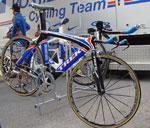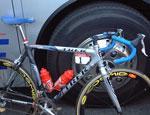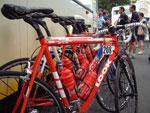| |
In the pits
 |
Built
to cut the air like a wire through cheese.
Photo: © Cyclingnews
Lance Armstrong's Tour de France prologue bike
If anything, US Postal's Trek-built TT bikes demonstrate that there's
plenty of latitude in the UCI rules for aerodynamic tweakage. Note how
the seat tube acts as a fairing round as much of the rear wheel as possible,
and the seat post has been replaced with an extended seat tube that goes
right up to the cradle. All within the letter of the rules, if perhaps
not within the intent.
USPS previously used welded Litespeed titanium bikes for the TT but now
is aboard moulded carbon fibre Treks developed with wind tunnel assistance
to make them as slippery as UCI rules allow.
|
 |
1030g
of carbon goodness
Photo: © Sirotti
USPS' stage bikes
Almost every team in the Tour was aboard bikes custom-made for the individual
riders, but Trek's carbon fibre frame-building process doesn't lend itself
to custom-building. USPS and even the Ancestor himself rode stock frames
that Trek is very fond of telling people are exactly what you can buy
in the shops. Armstrong had bikes in two variants: the standard 5500 and
the 5900 Superlight seen here. The 5900 uses more expensive but stronger
carbon fibre than the 5500; less of it is therefore needed to make the
frame and the bare frame weight is claimed to be 1,030g compared to 1,090g
for the 5500. Not a staggering difference, but on the Alpe d'Huez every
gram helps.
As befits USPS' stars-and-stripes-waving air, the Trek frames are made
in the company's Wisconsin factory using tubes supplied by MacLean Quality
Composites (MQC) of Sandy, Utah.
|
 |
Sivakov's
Look
Photo: © Sirotti
BigMAT's mystery Look
It's fair to say that the BigMAT team didn't exactly set the world alight
with their presence in this year's Tour, but they did have the distinction
of having Look bikes that were truly "none more red".
BigMAT nominally rides Look KG241 carbon fibre frames. The bikes in the
background are clearly lugged and bonded carbon jobs, but the front bike
— Alexei Sivakov's — looks suspiciously aluminium. We weren't
able to find out more at the time. Any inside info out there? Let
us know.
|
 |
Decathlon
— proof that chain stores can make pro bikes.
Photo: © Cyclingnews
Ag2r-Prévoyance's Decathlon bikes
Decathlon likes to be thought of a technical partner to the Ag2r team
rather than just a sponsor, and the company — a European sporting
goods store chain — has certainly shown every indication of being
serious about its commitment, ensuring that Ag2r's riders get bikes custom-made
for their needs and varying details like the size and rigidity of the
Dedacciai tubes so sprinters get stiffer bikes, climbers lighter ones.
For 2001 Ag2r-Prévoyance was the first team aboard Keith
Bontrager's new road wheels. More about them in our special
Bontrager sponsorship feature.
|
 |
Where
now for GT?
Photo: © Sirotti
GT's last hurrah?
While
the Lotto-Adecco team was campaigning the Tour, its bike sponsor GT was
rather messily floundering in financial dire straits, eventually filing
for Chapter 11 protection from creditors on July 16. Reports on the website
of US industry bible Bicycle Retailer put the combined debts of GT and
sister company Schwinn at $260 million, and Huffy is reported to have
offered $60 million for the company.
Schwinn/GT's future is expected to be determined sometime in mid-September;
it's unlikely that two such famous brands will be allowed to vanish, but
its also unlikely we'll ever see the sheer brashness that typified GT
in the early 90s
|




